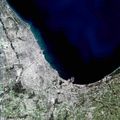Kendall County, Illinois | |
|---|---|
 | |
 Location within the U.S. state of Illinois | |
 Illinois's location within the U.S. | |
| Coordinates: 41°35′N88°26′W / 41.59°N 88.43°W | |
| Country | |
| State | |
| Founded | 1841 |
| Named after | Amos Kendall |
| Seat | Yorkville |
| Largest village | Oswego |
| Area | |
• Total | 322 sq mi (830 km2) |
| • Land | 320 sq mi (830 km2) |
| • Water | 2.0 sq mi (5.2 km2) 0.61% |
| Population (2020) | |
• Total | 131,869 |
• Estimate (2024) | 143,171 |
| • Density | 410/sq mi (160/km2) |
| Time zone | UTC−6 (Central) |
| • Summer (DST) | UTC−5 (CDT) |
| Congressional district | 14th |
| Website | www |

Kendall County is a county in the U.S. state of Illinois, within the Chicago metropolitan area. According to the 2020 census, it has a population of 131,869. [2] Its county seat is Yorkville, [3] and its most populous municipality is Oswego.
Contents
- History
- Early settlement and Native American presence
- Pioneer life and establishment of towns
- Role in the Underground Railroad
- Civil War and military contributions
- Industrialization and economic growth
- Impact of agriculture
- Suburbanization and population growth
- Geography
- Climate and weather
- Major highways
- Adjacent counties
- Demographics
- 2020 census
- 2010 census
- Communities
- Cities
- Villages
- Census-designated place
- Other unincorporated communities
- Townships
- Government
- Politics
- Property values
- Education
- In popular culture
- See also
- Notes
- References
- External links
Kendall County is part of the Chicago metropolitan area and was the fastest-growing county in the United States between 2000 and 2010. [4]



